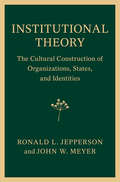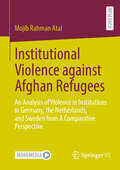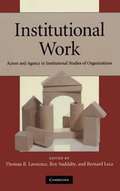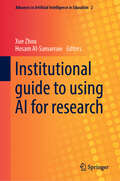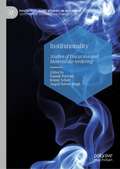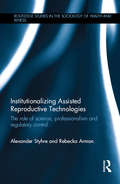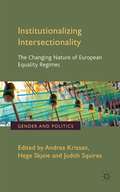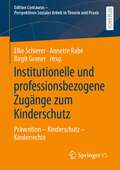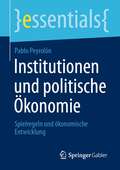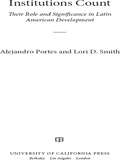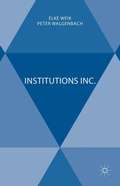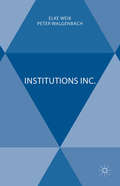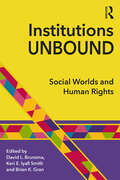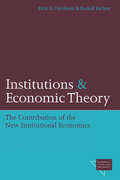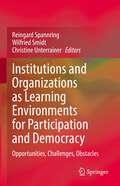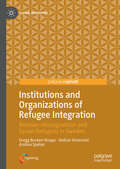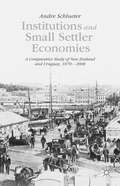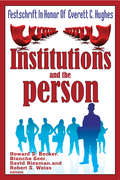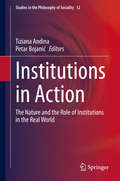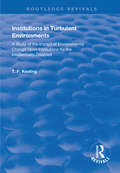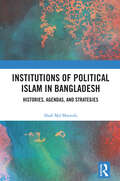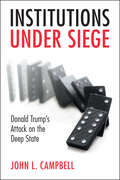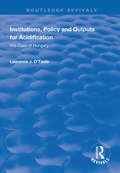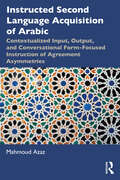- Table View
- List View
Institutional Theory: The Cultural Construction of Organizations, States, and Identities
by John W. Meyer Ronald L. JeppersonOver the past three decades, Meyer, Jepperson, and colleagues have contributed to the development of one of the leading approaches in social theory, by analyzing the cultural frameworks that have shaped modern organizations, states, and identities. Bringing together key articles and new reflections, this volume collects the essential theoretical ideas of 'sociological neoinstitutionalism.' It clarifies the core ideas and situates them within social theory writ large. Among other topics, the authors discuss the changing nature of the “actors” that have operated within contemporary social structure. The book concludes with the evolving frameworks that have structured social activity in the post–World War II period of 'embedded liberalism,' in the more recent neoliberal period, and in an emergent post-liberal period that appears to be a radical departure.
Institutional Violence against Afghan Refugees: An Analysis of Violence in Institutions in Germany, the Netherlands, and Sweden from A Comparative Perspective
by Mojib Rahman AtalThe long-lasting political instability in Afghanistan since the Soviet Union invasion in 1979 has displaced millions of Afghans, both internally and internationally. Despite their growing numbers, the challenges that Afghan refugees encounter in public institutions and everyday interaction with members of their host countries have remained largely uninvestigated. This research thus explores perceived institutional violence against Afghan refugees in Germany, the Netherlands, and Sweden. The semi-structured interviews provide evidence on the occurrence of perceived verbal violence, and differential and poor treatment in institutions. The quantitative analysis lends empirical evidence to the extent, factors, grounds, and consequences of institutional verbal violence, institutional failure, everyday discrimination, and sense of belonging. Permanent residence, school education, age, having children, country of residence, citizenship, and employment were identified as factors significantly affecting the experiences and perceptions of respondents. Respondents reported negative experiences mostly in institutions that often deal with migration and asylum matters. Legal status, ethnic origin, religion, unemployment, appearance, and lower language proficiency seem to be the main grounds for institutional violence.
Institutional Work: Actors and Agency in Institutional Studies of Organizations
by Thomas B. Lawrence Roy Suddaby Bernard LecaThe 'institutional' approach to organizational research has shown how enduring features of social life - such as marriage and bureaucracy - act as mechanisms of social control. Such approaches have traditionally focused attention on the relationships between organizations and the fields in which they operate, providing strong accounts of the processes through which institutions govern action. In contrast, the study of institutional work reorients these traditional concerns, shifting the focus to understanding how action affects institutions. This book sets a research agenda within the field of institutional work by analyzing the ways in which individuals, groups, and organizations work to create, maintain, and disrupt the institutions that structure their lives. Through a series of essays and case studies, it explores the conceptual core of institutional work, identifies institutional work strategies, provides exemplars for future empirical research, and embeds the concept within broader sociological debates and ideas.
Institutional guide to using AI for research (Advances in Artificial Intelligence in Education #2)
by Xue Zhou Hosam Al-SamarraieThis book provides a comprehensive exploration of the integration of artificial intelligence (AI) into academic research, specifically tailored for higher education institutions and postgraduate research (PGR) students. It addresses the unique challenges and opportunities that these institutions and students encounter when incorporating AI into research. The work emphasises practical case studies, step-by-step guides on AI tools and techniques, ethical considerations in AI usage, and features contributions from experts across various disciplines. Following the introduction, the book delves into the specifics of how AI can enhance academic research such as literature review, data analysis and interpretation, and assistance in academic writing across different disciplines. The wide range of topics introduced in this book is supported by practical examples and guidance. This book also explores the landscape of current AI applications in research, the methodologies for effectively leveraging AI technologies, and the critical ethical dimensions of AI work. The importance of interdisciplinary collaboration in expanding the use of AI in research is covered in this book by drawing on expert insights to provide a rich, multifaceted understanding of the potential of AI in academia. The combination of topics in this book can empower PGR students to navigate the complexities of AI in their research. The book is a much-needed compilation prepared by leading scholars in the field of digital technology to help PGRs, as well as decision-makers, determine the best ways to integrate and use AI tools in research.
Institutionality: Studies of Discursive and Material (Re-)ordering (Postdisciplinary Studies in Discourse)
by Yannik Porsché Ronny Scholz Jaspal Naveel SinghThis edited book brings together humanities and social sciences scholars from the various disciplines at the nexus of discourse studies and ethnography to reflect on questions of institutional practices and their political concerns. Institutional order plays an important role in structuring power relations in society. Yet, contrary to common understandings of structure, institutional orders are far from fixed or stable. They constantly change, and they are resisted and reimagined by social actors. The 20 studies collected in this edited volume develop the notion of institutionality as an overarching perspective to explore how institutional actors and institutional practices order and reorder power in societies across the globe. Thereby the chapters pay special attention to the fluidity, volatility, fragility, and ambiguity of order, and consequently to its claims to authority. Employing a broad range of discourse analytic and ethnographic methodologies, the studies show how institutions are discursively and materially constructed, defined, represented and how they are made relevant and become powerful – or how they are resisted, transformed or lose significance – in interaction. Readers will obtain nuanced insights into ways in which differently positioned social actors engage in struggles about how institutions can be imagined and enacted across several domains, such as workplace interactions, architecture, mass-media representations or organisational publicity. This book will be of interest to readers in Applied Linguistics, Discourse and Society, Critical Discourse Analysis, Political Theory and Communication Studies.
Institutionalizing Assisted Reproductive Technologies: The Role of Science, Professionalism, and Regulatory Control
by Alexander Styhre Rebecka ArmanReproductive medicine has been very successful at developing new therapies in recent years and people having difficulties conceiving have more options available to them than ever before. These developments have led to a new institutional landscape emerging and this innovative volume explores how health and social structures are being developed and reconfigured to take into account the increased use of assisted reproductive technologies, such as IVF treatments. Using Sweden as a central case study, it explores how the process of institutionalizing new assisted reproductive technologies includes regulatory agencies, ethical committees, political bodies and discourses, scientific communities, patient and activists groups, and entrepreneurial activities in the existing clinics and new entrants to the industry. It draws on new theoretical developments in institutional theory and outlines how health innovations are always embedded in social relations including ethical, political, and financial concerns. This book will be of interest to advanced students and academics in health management, science and technology studies, the sociology of health and illness and organisational theory.
Institutionalizing Intersectionality
by Judith Squires Andrea Krizsan Hege SkjeieAn exploration of the ways that multiple inequalities are being addressed in Europe. Using country-based and region-specific case studies it provides an innovative comparative analysis of the multidimensional equality regimes that are emerging in Europe, and reveals the potential that these have for institutionalizing intersectionality.
Institutionelle und professionsbezogene Zugänge zum Kinderschutz: Prävention – Kinderschutz – Kinderrechte (Edition Centaurus - Perspektiven Sozialer Arbeit in Theorie und Praxis)
by Elke Schierer Annette Rabe Birgit GronerDas Thema Kinderschutz wird in diesem Band multiperspektivisch auf Ebene der Prävention, des Kinderschutzes per se und der Kinderrechte betrachtet und diskutiert. Hierbei spielen institutionelle und professionsbezogene Zugänge und Entwicklungen eine wesentliche Rolle. Das Aufwachsen von Kindern und Jugendlichen in der heutigen Gesellschaft geschieht in einer Spätmoderne, die gekennzeichnet ist von gesellschaftlichen Transformationsprozessen in verschiedenen Bereichen. Die Veränderungen in den Teilsystemen, zu denen Kinder und Jugendliche gehören wie Familien und Institutionen des öffentlichen Lebens, sind interdependent mit anderen Teilsystemen. Die Subjektorientierung und Anerkennung von Kinderrechten darf nicht darüber hinwegtäuschen, dass diese Verschränkung der geteilten Verantwortung im Kontext der Transformationsprozesse ein gelingendes Aufwachsen nicht an allen Orten und für alle Kinder und Jugendlichen ermöglicht. Die Beiträge des Bandes beziehen sich auf diese Prozesse und versuchen, dem Thema Kinderschutz in der Gesamtheit gerecht zu werden.
Institutionen und politische Ökonomie: Spielregeln und ökonomische Entwicklung (essentials)
by Pablo PeyrolónPablo Peyrolón gibt eine kurze Einführung in die Institutionsökonomie. Die Institutionen sind die Spielregeln der Gesellschaft, der Wirtschaft und der Politik, deren Dynamik der Autor hier darlegt. Das Verständnis der institutionellen Evolution ermöglicht auch eine Analyse der Formung der Wirtschaftspolitik und des ökonomischen Wandels sowie des Zusammenhangs mit dem digitalen Wandel.
Institutions Count
by Alejandro Portes Lori D. SmithWhat leads to national progress? The growing consensus in the social sciences is that neither capital flows, nor the savings rate, nor diffuse values are the key, but that it lies in the quality of a nation's institutions. This book is the first comparative study of how real institutions affect national development. It seeks to examine and deepen this insight through a systematic study of institutions in five Latin American countries and how they differ within and across nations. Postal systems, stock exchanges, public health services and others were included in the sample, all studied with the same methodology. The country chapters present detailed results of this empirical exercise for each individual country. The introductory chapters present the theoretical framework and research methodology for the full study. The summary results of this ambitious study presented in the concluding chapter draw comparisons across countries and discuss what these results mean for national development in Latin America.
Institutions Inc.
by Peter Walgenbach Elke WeikInstitutions Incorporated draws together aspects of human and organizational corporeality and links them to institutions. Throughout European anthropology and culture the body has been conceptualized as the 'dark side' to soul and reason. This book explores the 'dark side' of institutions, their materiality and the bodily involvement of their users, in an environment where perfection is measured in intangible entities, notably reason and will. This innovative collection takes a closer look at the interplay of the symbolic and the material, and the triad of institutions, bodies and corporations. This exciting research examines what the tangible, 'dark side' of institutions means both for those who live in them, and those who study them.
Institutions Inc.
by Peter Walgenbach Elke WeikInstitutions Incorporated draws together aspects of human and organizational corporeality and links them to institutions. Throughout European anthropology and culture the body has been conceptualized as the 'dark side' to soul and reason. This book explores the 'dark side' of institutions, their materiality and the bodily involvement of their users, in an environment where perfection is measured in intangible entities, notably reason and will. This innovative collection takes a closer look at the interplay of the symbolic and the material, and the triad of institutions, bodies and corporations. This exciting research examines what the tangible, 'dark side' of institutions means both for those who live in them, and those who study them.
Institutions Unbound: Social Worlds and Human Rights
by Keri E. Iyall Smith David L. Brunsma Brian K. GranInstitutions--like education, family, medicine, culture, and law--, are powerful social structures shaping how we live together. As members of society we daily express our adherence to norms and values of institutions as we consciously and unconsciously reject and challenge them. Our everyday experiences with institutions not only shape our connections with one another, they can reinforce our binding to the status quo as we struggle to produce social change. Institutions can help us do human rights. Institutions that bridge nation-states can offer resources, including norms, to advance human rights. These institutions can serve as touch stones to changing minds and confronting human rights violations. Institutions can also prevent us from doing human rights. We create institutions, but institutions can be difficult to change. Institutions can weaken, if not outright prevent, human rights establishment and implementation. To release human rights from their institutional bindings, sociologists must solve riddles of how institutions work and determine social life. This book is a step forward in identifying means by which we can loosen human rights from institutional constraints.
Institutions and Economic Theory: The Contribution of the New Institutional Economics
by Furubotn Eirik G. Richter RudolfA much-needed exploration of the New Institutional Economics, or NIE, including a critical assessment of its central theoretical contributions since the field's early beginnings in the 1960s, is this book's objective. It traces the development of major ideas about the genesis and significance of institutions as these ideas have been presented in the NIE. Given the fundamental understanding underlying work in this new area of research--that transactions involve the use of real resources and have costs--the book views the NIE as an amalgam of transaction-cost economics, property-rights analysis, and contract theory. Efforts are made to explain how the various theoretical strands discussed in the NIE literature fit into the general fabric of modern institutionalism, and how the new concepts put forward can be applied to institutional analysis. Since the new institutionalist approach contrasts sharply with that of the traditional neoclassical model, special attention is given to elucidating the points of difference between the two. And, along these lines, a final chapter deals with the troubling question of whether neoinstitutionalist theory can be advanced by efforts to extend or generalize neoclassical theory. The book will be essential reading for economists attracted to the NIE approach. In addition, scholars from such disciplines as political science, sociology, and law will find the work useful as the NIE continues to gain wide academic acceptance. Eirik G. Furubotn is currently serving as Research Associate, University of Texas at Arlington; he recently retired as James L. West Professor of Economics, Texas A&M University. Rudolf Richter is Professor of Economics, Center for the Study of the New Institutional Economics, University of Saarlandes.
Institutions and Organizations as Learning Environments for Participation and Democracy: Opportunities, Challenges, Obstacles
by Wilfried Smidt Reingard Spannring Christine UnterrainerThis book discusses opportunities and limitations to democratic participation in institutions and organizations across the life course. It demonstrates that democratic participation is not something that is learned once and for all and applied in formal political settings, but something that is lived every day throughout life in various contexts. Institutions and organizations frame human lives and strongly determine the ability to participate and co-determine their communities. They are places for learning, deliberation and the development of the common good. The book conceptually and empirically analyses the potential of democratic participation within various institutions. The contributions range from early childhood institutions, schools, youth programs, workplaces, and vocational education to cultural organizations and nursing homes for the elderly. The book thereby provides a cross-sectional and interdisciplinary knowledge base to inspire future research and practical efforts to promote democratic participation within and across institutions around the world.
Institutions and Organizations of Refugee Integration: Bosnian-Herzegovinian and Syrian Refugees in Sweden (Global Diversities)
by Gregg Bucken-Knapp Vedran Omanović Andrea SpeharThis book examines the integration experiences of refugees to Sweden from Bosnia and Herzegovina (1992-1995), and more recently from Syria (2014-2018) - two of the largest-scale refugee movements in Europe for the last thirty years. It focuses on refugees’ interactions with key institutions of integration including language training, civic orientation, validation of previous educational experience, organizations and multiple labour market initiatives targeting refugees. Drawing on interviews with the refugees themselves, it offers a nuanced analysis of how the institutions of integration operate on a daily basis, and the effects they have on the lives of those who take part in them. The authors’ comparative approach highlights the particularities of each refugee movement while also revealing developments and persistent issues within institutions of integration in the intervening years between the Bosnian-Herzegovinian and Syrian conflicts. Its conclusion, which situates the Swedish case within the broader European context, demonstrates the wider significance of this timely study. It will provide a valuable resource for policymakers in addition to students and scholars of migration studies, social policy, and public policy and business administration.
Institutions and Small Settler Economies
by Andre SchlueterInstitutions and Small Settler Economies provides a comprehensive improvement in our understanding of institutional contributions to economic growth.
Institutions and the Person: Festschrift in Honor of Everett C.Hughes
by Howard Saul Becker Robert S. Weiss David Riesman Blanche GeerEverett C. Hughes had a great impact on the field of sociology as a whole and on an entire generation of sociologists. Some of Hughes' former students and colleagues honor him in this book. The essays address the main themes in his work over the years, and illustrate as well Hughes' impact on the contributors, many of whom are themselves senior figures in the field. The book as a whole provides a distinguished and representative sampling of a major stream of contemporary sociological thought. Each of the five main divisions in the book covers one aspect of Hughes' work. The first deals with the study of occupations and professions-a field in which Hughes was a leader. The second section deals with race relations and other situations in which peoples of differing cultures meet. Beginning with his own work in French Canada many years ago, Hughes interests spread, and the breadth of this interest is seen in chapters on India, Peru, and race relations in the United States. Problems of organizations-how they are put together and how they work-are contained in a third section. A fourth section reflects Hughes' interest in the impact of institutional experience on the people who participate in social institutions, and includes chapters on occupational socialization, status passage, and the use of drugs. A final section develops still another of Hughes' interests-social science method. Presenting some of the most important topics of contemporary theory and research, this book remains profitable reading for every member of the discipline
Institutions in Action: The Nature and the Role of Institutions in the Real World (Studies in the Philosophy of Sociality #12)
by Tiziana Andina Petar BojanićThis edited volume presents the social ontology of institutions. It questions what institutions are, what features and properties institutions have and what kinds of institution are present in the social world. The book answers these questions from both a speculative and an applied approach, it argues for a specific definition of institutions as a rule-based equilibria, as collective epistemic agent that is characterized by meaning, principles and power and as product of a We-mode and an imposition of a function. This book started from the interdisciplinary conference Playing by the Rules in Rijeka and contains contributions from Philosophy, Sociology and Economy.Institutions in Action is the first book to offer a comprehensive overview of the many different aspects and accounts about the social ontology of institutions. This much needed book presents researchers a very wide state of the art about the topic of institution by presenting the many differences that emerge in comparing the different positions.
Institutions in Turbulent Environments: A Study of the Impact of Environmental Change upon Institutions for the Intellectually Disabled (Routledge Revivals)
by T.P. KeatingPublished in 1999. Contemporary organizations are faced with increasingly rapid and dramatic change within their political, cultural and technological environments. Institutions in Turbulent Environments critically examines the way organizations respond to these changes,with a particular focus upon the institutional disability sector. The book examines available theory concerning organizational contingency, adaptation and population ecology. It utilizes a framework developed from this theory to examine the ways in which a major institution for the intellectually disabled responded to the turbulence within its environment. It uses this data to re-examine theory and to propose changes to the way organization/environment relationships are understood.
Institutions of Political Islam in Bangladesh: Histories, Agendas, and Strategies
by Shafi Md MostofaThis book examines the socio-political histories, religio-political agendas and politico-militant (and for some, non-violent) strategies of institutions of political Islam in Bangladesh. Focusing on Jammat-e-Islami, Hefazet-e-Islam, Jammatul Mujahedeen Bangladesh (JMB), Ansar al Islam, Neo-Jammatul Mujahedeen Bangladesh (Neo-JMB), Tablighi Jamaat, and Islami Andolon Bangladesh, it shows how these groups are key actors in the securitization of the postcolonial socio-cultural, economic, and political histories (and future) of Bangladesh.The volume illustrates the complex ways in which every day lived experiences of peoples of Bangladesh, and securitized political and cultural pathways of state governance have shaped and impacted the histories and activities of these groups, and the strategies and agendas of these groups to gain political and socio-religious legitimacy within (and sometimes, beyond) the secularized cultural landscapes of Bangladesh. Moreover, the book argues that even though these Islamist groups bear the same agenda of transforming Bangladesh into an Islamic state, their strategies are different and unique. It also discusses the connections of some of these groups to other transnational institutions of political Islam and extremist groups such as Al-Qaeda and the Islamic State (IS).This book will be a major intervention in the field of politics, religion, and South Asian studies.
Institutions under Siege: Donald Trump's Attack on the Deep State
by John L. CampbellMuch of the research on institutional change shows how systems shift slowly and incrementally. Yet, in the case of former President Donald Trump, change was rapid and radical. In Institutions Under Siege, leading political sociologist John L. Campbell offers new insights for understanding the legacy of the Trump presidency. The book examines Trump's attack on the 'deep state' through the lens of institutional change theory, and demonstrates how he capitalized on tipping points and distinct leadership tactics to inspire, make deals with, and threaten people to get what he wanted. The book also assesses where the damage caused by the Trump administration is most likely to endure and where long-lasting damage was prevented. Sharp and insightful, Institutions Under Siege contrasts existing social science literature to draw attention to the unique significance of tipping points and the characteristics of particular leaders.
Institutions, Institutional Change and Economic Performance
by Douglass C. NorthContinuing his groundbreaking analysis of economic structures, Douglass North develops an analytical framework for explaining the ways in which institutions and institutional change affect the performance of economies, both at a given time and over time. Institutions exist, he argues, due to the uncertainties involved in human interaction; they are the constraints devised to structure that interaction. Yet, institutions vary widely in their consequences for economic performance; some economies develop institutions that produce growth and development, while others develop institutions that produce stagnation. North first explores the nature of institutions and explains the role of transaction and production costs in their development. The second part of the book deals with institutional change. Institutions create the incentive structure in an economy, and organizations will be created to take advantage of the opportunities provided within a given institutional framework. North argues that the kinds of skills and knowledge fostered by the structure of an economy will shape the direction of change and gradually alter the institutional framework. He then explains how institutional development may lead to a path-dependent pattern of development. In the final part of the book, North explains the implications of this analysis for economic theory and economic history. He indicates how institutional analysis must be incorporated into neo-classical theory and explores the potential for the construction of a dynamic theory of long-term economic change. Douglass C. North is Director of the Center of Political Economy and Professor of Economics and History at Washington University in St. Louis. He is a past president of the Economic History Association and Western Economics Association and a Fellow, American Academy of Arts and Sciences. He has written over sixty articles for a variety of journals and is the author of The Rise of the Western World: A New Economic History (CUP, 1973, with R. P. Thomas) and Structure and Change in Economic History (Norton, 1981). Professor North is included in Great Economists Since Keynes edited by M. Blaug (CUP, 1988 paperback ed. )
Institutions, Policy and Outputs for Acidification: The Case of Hungary (Routledge Revivals)
by Lawrence J. O'Toole, JrPublished in 1998, this is an analysis of the impact in Hungary of environmental policy following the Convention of Long Range Trans-boundary Air Pollution (CLRTAP) of the Economic Commission of Europe. The book focuses on central research issues but also analyzes environmental institutions and policy in Hungary more generally. It treats related themes such as the emerging role of the new autonomous local governments, the impact of privatization on acidification and environmental issues in Hungary and offers coverage of the influence of NGO's in democratic Hungary.
Instructed Second Language Acquisition of Arabic: Contextualized Input, Output, and Conversational Form-Focused Instruction of Agreement Asymmetries
by Mahmoud AzazInstructed Second Language Acquisition of Arabic examines the acquisition of agreement asymmetries in the grammatical system of Arabic as a second/foreign language through the lens of instructed second language acquisition. The book explores how to improve the processes of L2 learning of Arabic using evidence-based classroom research. Before it does this, it characterizes the variable challenges that English L2 learners of Arabic face when they acquire four structural cases in Arabic grammar that entail agreement asymmetries. Using the pretest–posttest design, it examines the effects of four classroom interventions using quantitative and qualitative measures. In these interventions, form-based and meaning-based measures were used to reveal to what degree learners have developed explicit and implicit knowledge of these aspects of asymmetry. In the concluding chapter, the book provides focused and specific implications based on the results of the four studies. It provides theoretical implications that enrich the discussions of instructed second language Acquisition in Arabic and other languages more broadly. It also provides implications for teachers, curriculum designers, and textbook writers of Arabic. This book will be informative for Arabic applied linguists, researchers of Arabic SLA, Arabic instructors (at the K–12 and the college level), and Arabic program directors and coordinators. The book will also appeal to all SLA and ISLA researchers.
